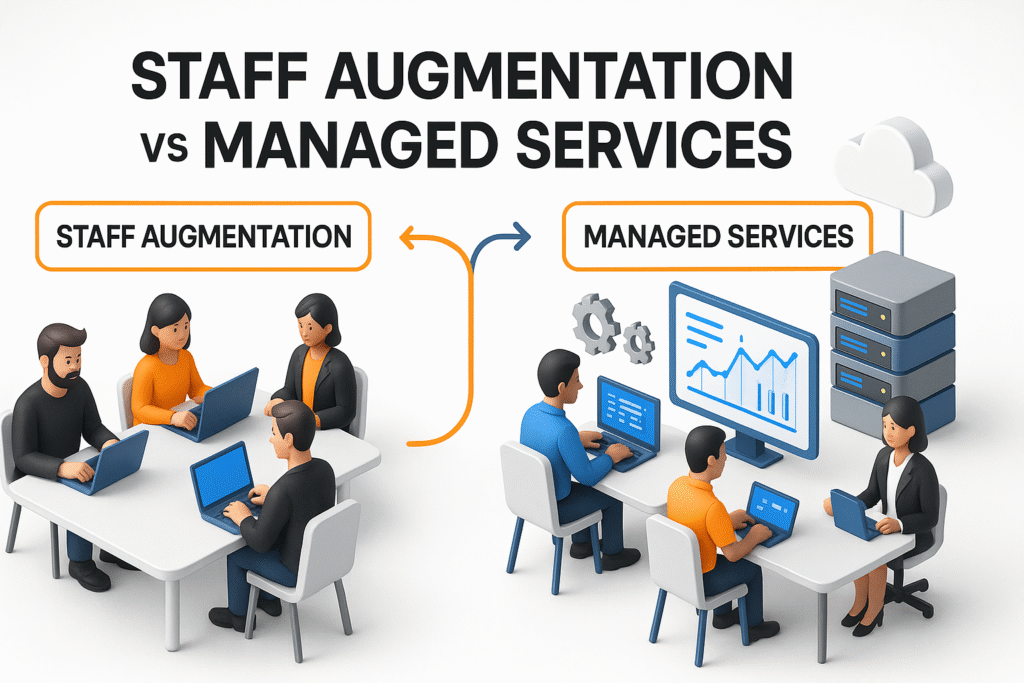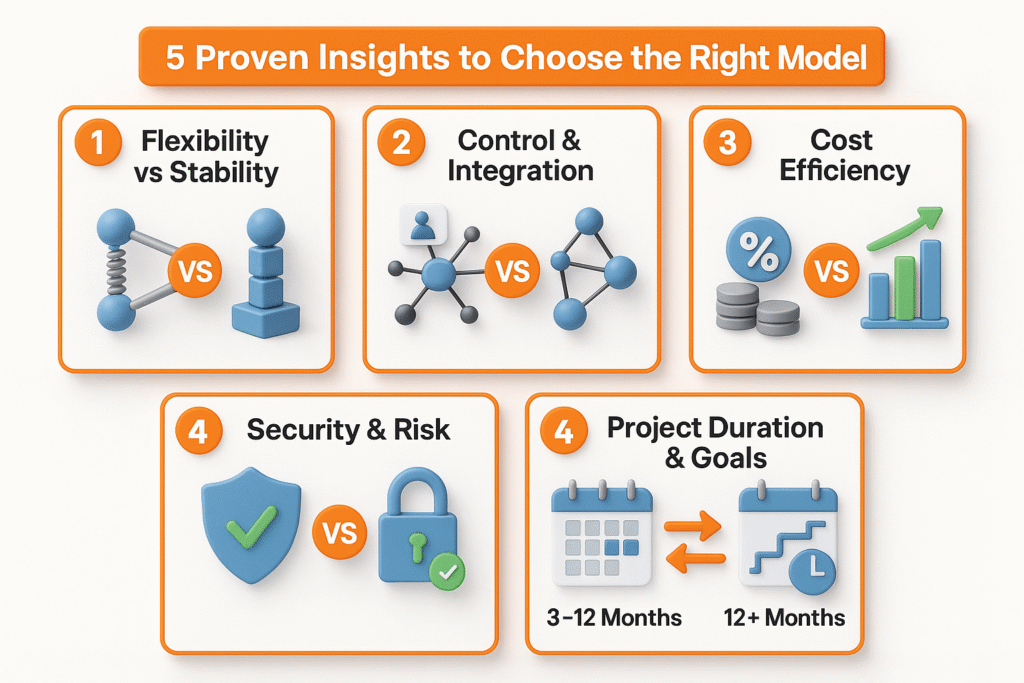Offshore Development Center Setup: Complete Business GuideStaff augmentation vs managed services represents one of the most critical decisions you will face as a CTO, startup founder, or tech leader when scaling your software development team. Hiring full-time employees takes months, costs surge unpredictably, and finding the right expertise feels nearly impossible in today’s competitive market. The solution lies in IT outsourcing through either staff augmentation or managed services.
Both staff augmentation and managed services help businesses access specialized technical talent without the overhead of permanent hiring, but they work fundamentally differently. Staff augmentation lets you handpick developers who integrate directly into your existing team with full control over daily operations. Managed services outsource entire IT functions to external providers who handle everything from planning to execution.
Choosing the wrong model in the staff augmentation vs managed services debate can drain your budget, delay critical projects, and create management headaches. This guide reveals 5 proven insights to help you make the smartest decision for your business goals, project timeline, and budget constraints.

What is Staff Augmentation?
Staff augmentation is a flexible IT outsourcing strategy where businesses temporarily hire external developers or technical specialists to supplement their existing in-house teams. This model provides immediate access to pre-vetted professionals who possess specific skills your current team lacks, without long-term commitment or overhead costs of full-time employment.
According to Statista research, the IT outsourcing market continues rapid growth, with demand for staff augmentation services increasing from 5.2% in 2018 to 6.3% by 2020. The IT Staff Augmentation and Managed IT Services market reached $50 billion in 2025, with projections showing a 15% CAGR through 2033, driven by increasing demand for specialized IT skills and flexible workforce solutions.
Augmented developers work under your direct supervision, follow your company’s methodologies and workflows, and integrate seamlessly with your existing team culture. You maintain complete control over project execution while the augmentation provider handles recruitment, payroll, and administrative tasks.
Key characteristics include:
-
Temporary engagement aligned with specific project timelines
-
Direct management and control by your internal team
-
Flexible scaling with rapid team expansion or reduction
-
Pay-as-you-go pricing based on hourly or monthly rates
-
Access to specialized technical skills not available in-house
-
Quick onboarding with minimal training required
Ready to expand your team? Hire dedicated developers from RSquare Technologies and access senior-level talent within days.
What are Managed Services?
When comparing staff augmentation vs managed services, managed services involve outsourcing complete IT functions or entire projects to a third-party managed service provider (MSP) who assumes full responsibility for planning, implementation, monitoring, maintenance, and support. Unlike staff augmentation where you retain control, managed services transfer operational authority to the provider.
According to Market.US research, the offshore software development outsourcing market is projected to reach $389.7 billion by 2033, growing at a CAGR of 12.5%. The managed services market specifically will reach USD 354.8 billion by 2026, growing at 7.9% CAGR, reflecting increasing business recognition of outsourcing efficiency.
MSPs operate based on defined Service Level Agreements (SLAs) specifying performance metrics, uptime guarantees, response times, and deliverable quality standards. This model provides predictable costs through subscription-based or fixed-fee pricing structures, eliminating budget surprises.
Primary benefits include:
-
Proactive 24/7 monitoring and issue resolution
-
Access to diverse technical expertise across multiple domains
-
Predictable monthly costs enabling accurate budget forecasting
-
Enhanced security protocols and risk management frameworks
-
Scalability to accommodate business growth without recruiting overhead
-
Reduced internal management burden
Explore custom software development services and web development solutions from RSquare Technologies.
Staff Augmentation vs Managed Services: Key Differences
Understanding the fundamental distinctions in the staff augmentation vs managed services comparison is essential for making an informed outsourcing decision. While both models provide access to external technical expertise, they differ significantly in control structure, engagement approach, cost models, and operational integration.
| Factor | Staff Augmentation | Managed Services |
|---|---|---|
| Control & Management | Client retains full operational control | Provider independently manages operations |
| Engagement Duration | Short to medium-term (3-12 months) | Long-term partnerships (12+ months) |
| Cost Structure | Variable pay-as-you-go pricing | Fixed subscription or monthly fees |
| Scalability | Highly flexible with rapid scaling | Structured scaling through planning |
| Accountability | Client bears primary project risks | Shared accountability with provider |
| Team Integration | Works within client’s existing team | Operates independently |
| Expertise Access | Limited to hired resources | Broad access to entire talent pool |
| Best Suited For | Specific skill gaps and projects | Ongoing operations and function outsourcing |
According to Deloitte’s global outsourcing research, 70% of organizations worldwide consider reduced costs as one of the significant aspects defining their IT outsourcing strategy, whether choosing staff augmentation or managed services. Learn more in our outsourcing software development startups guide.
5 Proven Insights to Choose the Right Model
Selecting between staff augmentation vs managed services requires careful evaluation of your business circumstances, project requirements, and strategic goals. These five insights provide a decision-making framework based on industry best practices.

Insight 1: Flexibility vs Stability
When evaluating staff augmentation vs managed services, staff augmentation delivers unmatched flexibility for businesses with evolving requirements or fluctuating workloads. You can rapidly scale your team during peak periods and scale down when projects complete without long-term obligations. Research from Forbes indicates companies can save up to 70% on operational costs through strategic IT outsourcing.
Managed services prioritize stability through consistent support ideal for ongoing operations requiring continuous monitoring and reliable uptime guarantees. Organizations dependent on critical IT infrastructure benefit from MSPs’ proactive approach and established incident response protocols.
Choose staff augmentation when:
-
Project requirements change frequently based on market feedback
-
You need specialized skills for specific development phases
-
Maintaining direct control over operations is essential
-
Your internal team has capacity to oversee additional resources
Choose managed services when:
-
You require ongoing IT infrastructure management with guaranteed uptime
-
Predictable monthly budgets are business priorities
-
Reducing management overhead frees leadership for strategic focus
-
Business continuity and 24/7 support are critical
Explore hire dedicated Laravel developers or hire PHP developers from RSquare Technologies.
Insight 2: Control and Team Integration
In the staff augmentation vs managed services decision, control represents a critical factor. Staff augmentation keeps you in the driver’s seat with augmented professionals functioning as seamless extensions of your team. They participate in daily standups, use your project management tools, and follow your coding standards.
This deep integration enables real-time collaboration and immediate course corrections when priorities shift. According to industry data, 68% of companies using staff augmentation report it helps reduce time-to-hire by 30-50%.
Managed services transfer operational control to the provider who independently manages tasks and delivers outcomes based on agreed specifications and SLAs. Communication flows through designated account managers using structured reporting schedules. This reduces your management burden but limits ability to make rapid tactical adjustments.
Insight 3: Cost Efficiency and Budget Predictability
When comparing staff augmentation vs managed services from a financial perspective, staff augmentation employs hourly or project-based pricing offering excellent cost efficiency for short-term needs since you only pay for exact skills and time utilized. You avoid overhead expenses like benefits, training programs, or office space.
Managed services utilize subscription-based or fixed-fee pricing delivering exceptional budget predictability through consistent monthly costs. While potentially higher upfront, this model frequently delivers superior long-term value through economies of scale and comprehensive service coverage.
According to KMPG research, 32.3% of companies outsource software development because it costs less than hiring an in-house team. MSPs spread infrastructure investments and expert personnel costs across multiple clients, passing efficiency savings along through competitive pricing.
Review our guide on IT staff augmentation cost and 5 proven pricing models.
Insight 4: Security, Risk Management, and Accountability
Security considerations in staff augmentation vs managed services differ significantly. Staff augmentation provides tighter security controls since augmented professionals integrate with your team under your supervision, internal security policies, and non-disclosure agreements. You maintain direct visibility over code repositories, data access permissions, and development practices.
Your organization controls onboarding procedures, security training, and can immediately revoke permissions if concerns arise. Augmented team members work within your existing security infrastructure using your approved tools and authentication systems.
Managed services require trusting the provider’s security infrastructure, compliance certifications, and data protection standards. Reputable MSPs invest heavily in enterprise-grade security including encryption, intrusion detection, and compliance with ISO 27001, SOC 2, or GDPR standards as outlined by leading cybersecurity frameworks.
The shared accountability model means the provider assumes contractual responsibility for delivering agreed outcomes and maintaining security standards specified in SLAs.
Insight 5: Project Duration and Business Goals Alignment
Timeline considerations in staff augmentation vs managed services are crucial. Staff augmentation excels for short to medium-term projects typically ranging from 3 to 12 months requiring specific expertise your permanent team lacks. Common scenarios include MVP development, adding product features, technology migrations, or accessing specialized skills for one-time initiatives.
The temporary engagement structure aligns perfectly with project lifecycles, allowing you to bring in specialized talent exactly when needed and release them when that phase completes without HR complications.
Managed services suit long-term engagements exceeding 12 months involving entire function outsourcing such as ongoing application maintenance, cloud infrastructure management, or security monitoring. IDC research indicates 70% of companies leverage managed IT services for efficiency and security.
Choose this model when you want to free internal resources to focus on strategic product development while providers handle operational necessities. Explore our build vs buy vs outsource decision framework and in-house vs outsourcing development guides.
Why Partner with RSquare Technologies
When making your staff augmentation vs managed services decision, RSquare Technologies delivers comprehensive IT outsourcing solutions tailored to your unique requirements. Whether you need flexible staff augmentation or full-scale managed services, our proven expertise spanning custom software development, Laravel applications, eCommerce platforms, and dedicated teams across multiple technology stacks helps startups and tech-focused businesses scale efficiently.
Our capabilities include:
-
Pre-vetted senior developers specializing in PHP, Laravel, Node.js, React, Angular, WordPress, Shopify, and Magento
-
Flexible engagement models matching your timeline and budget
-
40-hour risk-free trial period for evaluation
-
Transparent communication and seamless workflow integration
-
Proven track record delivering scalable solutions
-
Competitive pricing without hidden fees
Whether building an MVP, scaling existing applications, or outsourcing critical IT functions, RSquare Technologies provides the expertise and partnership approach you need to succeed.
Ready to accelerate your development?
Frequently Asked Questions
What is the main difference between staff augmentation and managed services?
The main difference in staff augmentation vs managed services lies in control and responsibility. Staff augmentation provides temporary team members who work under your direct management, giving you full operational control. Managed services transfer complete responsibility to an external provider who independently manages operations based on Service Level Agreements (SLAs).
Which is more cost-effective: staff augmentation or managed services?
Cost-effectiveness in staff augmentation vs managed services depends on your needs and timeline. Staff augmentation offers better value for short-term projects (3-12 months) with variable pay-as-you-go pricing. Managed services provide better long-term value for ongoing operations (12+ months) through predictable fixed monthly costs and economies of scale.
Can I use both models together?
Yes, many organizations adopt hybrid approaches combining both staff augmentation and managed services strategically. You might use staff augmentation for specialized projects while leveraging managed services for ongoing infrastructure maintenance and security monitoring. This balanced strategy maximizes strengths from both models.
How quickly can I start with staff augmentation?
Staff augmentation offers rapid deployment, typically providing qualified developers within days to a few weeks. Once you define your requirements, reputable providers like RSquare Technologies can match you with pre-vetted professionals from their existing talent pool.
What types of projects suit managed services?
Managed services excel for long-term operational requirements including continuous application maintenance, cloud infrastructure management, 24/7 security monitoring, help desk services, disaster recovery planning, and complete IT function outsourcing.
Is my data secure with managed services providers?
Data security with managed services depends on selecting reputable MSPs with robust security protocols and compliance certifications. Leading providers implement enterprise-grade security including data encryption, multi-factor authentication, regular security audits, and compliance with ISO 27001, SOC 2, and GDPR standards.
Conclusion
The staff augmentation vs managed services decision is not about identifying which model is universally better but determining which approach aligns with your specific project requirements, budget parameters, desired control level, and long-term strategic objectives.
Staff augmentation provides flexibility, direct control, and cost efficiency for short to medium-term projects requiring specialized technical skills. Managed services offer stability, comprehensive expertise, hands-off operations, and predictable costs for long-term IT management needs.
Many successful organizations adopt hybrid approaches, strategically combining staff augmentation and managed services to maximize strengths while minimizing limitations.
Ready to make the smartest scaling decision? Consult with RSquare Technologies’ experienced team to determine the optimal IT outsourcing strategy aligned with your goals.
Take action today:



